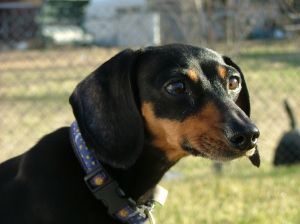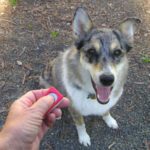When Sherry noticed that the muzzle of her six-year-old Dachshund was wet all day, she assumed Jenny had been drinking a little more water than usual. However, when she later approached the dog’s water dish, almost all of the morning’s water was still there. A closer look at Jenny revealed some blood around her mouth. After this continued for a few days, Sherry took her dog to the vet. The diagnosis was salivary mucocele in dogs.
Causes
According to PetPlace.com, salivary mucocele in dogs is a layer of granulated tissue around a salivary gland or salivary duct. Its cause is leakage of saliva into surrounding tissues.
Saliva is the substance that kicks off digestion. Several salivary glands produce it in dogs. If a salivary gland or a salivary duct becomes damaged, saliva leaks into the surrounding tissue of the mouth, where it collects and creates a mucocele.
The Michigan Veterinary Specialists practice indicates that vets are usually unable to find out exactly what was responsible. However, trauma like pressure from a choke chain or bites to the neck is a probable culprit.
Eventually, the dog’s body responds to the irritation saliva causes by producing a layer of inflamed tissue known as granulation tissue. The American College of Veterinary Surgeons reports that granulation tissue forms the lining of the mucocele. Swelling develops in the neck or mouth as saliva continues to leak, resulting in a major inflammatory process.
Salivary mucoceles in cats are extremely rare. Canine breeds particularly at risk for developing them are German Shepherds, Australian Silky Terriers, Poodles, and Dachshunds.
Many veterinarians seldom if ever see a dog with a salivary mucocele. Sharon Deemer, a licensed veterinary technician in Virginia, cites “a rate of fewer than 20 in 4,000 dogs.” I have seen just one in a dog I helped rescue, Jenny.
The signs of this disorder vary according to the type of mucocele present. General symptoms include difficulty eating, bleeding during or after chewing, and respiratory distress.
Owners of dogs with a cervical mucocele will see a swelling either on the side of the dog’s neck or under it. However, with a pharyngeal mucocele, the swelling occurs at the back of the throat and isn’t visible. The dog will probably have trouble breathing and will need to undergo anesthesia for the vet can get a good look the throat.
A pet with a zygomatic mucocele has swelling below an eye. When swelling appears under the dog’s tongue, the mucocele is probably a rannula, caused by damage to the sublingual ducts or sublingual salivary gland.
Diagnosis and Treatment
The only way to accurately diagnose salivary mucocle is microscopic evaluation of a sample of fluid from the swollen area. Any cells captured should be stained so they’ll stand out from cells that indicate an infection.
Although surgery is the only permanent cure, some vets attempt to drain a mucocele using a needle. Sometimes it’s necessary to lance the mucocele periodically or leave a drain in place for a certain time.
The type of surgery appropriate for each dog depends on the type of mucocele present. One technique is creating a pouch with an opening so that saliva can leak directly into the dog’s mouth with causing any swelling. In many cases, vets find it necessary to remove the salivary gland affected as well as the duct associated with it.
Dogs who undergo surgery have pain management plans. In addition to prescribing antibiotics, vets make sure that owners have oral or injectable painkillers to administer once the dog goes home.
Once Jenny had surgery to correct a salivary mucoclele, the vet told her owner to limit the dog’s exercise for around three weeks. Since Jenny also had a surgical drain, Sherry needed to check it frequently until it came out a week and half after the operation. Sherry also needed to be on the lookout for any signs of infection around her pet’s incision. Some dogs develop a seroma, a kind of soft swelling, after surgery for a salivary mucocele. Fortunately, Jenny wasn’t one of them.
Sources:
http://www.petplace.com/dogs/salivary-mucocele-in-dogs/page2.aspx
http://www.michvet.com/Client%20Education%20Handouts/Surgery%20handouts/Salivary%20mucoceles.pdf
http://www.acvs.org/AnimalOwners/HealthConditions/SmallAnimalTopics/SalivaryMucocele/
Sharon Deemer, licensed veterinary technologist, telephone conversation dated November 18, 2010.




